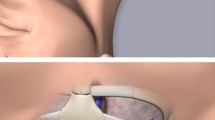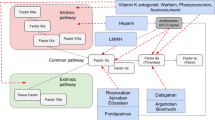Abstract
Background
We conducted a nationwide questionnaire-based survey to understand the current situation regarding central venous port implantation in order to identify the ideal procedure.
Methods
Questionnaire sheets concerning the number of implantation procedures and the incidence of complications for all procedures completed in 2012 were sent to 397 nationwide designated cancer care hospitals in Japan in June 2013. Venipuncture sites were categorized as chest, neck, upper arm, forearm, and others. Methods were categorized as landmark, cut-down, ultrasound-mark, real-time ultrasound guided, venography, and other groups.
Results
We received 374 responses (11,693 procedures) from 153 centers (38.5 %). The overall complication rates were 7.4 % for the chest (598/8,097 cases); 6.8 % for the neck (157/2325); 5.2 % for the upper arm (54/1,033); 7.3 % for the forearm (9/124); and 6.1 % for the other groups (7/114). Compared to the chest group, only the upper arm group showed a significantly lower incidence of complications (P = 0.010), and multivariate logistic regression (odds ratio 0.69; 95 % confidence interval 0.51–0.91; P = 0.008) also showed similar findings. Real-time ultrasound-guided puncture was most commonly used in the upper arm group (83.8 %), followed by the neck (69.8 %), forearm (53.2 %), chest (41.8 %), and other groups (34.2 %).
Conclusion
Upper arm venipuncture with ultrasound guidance seems the most promising technique to prevent complications of central venous port implantation.
Similar content being viewed by others
References
Niederhuber JE, Ensminger W, Gyves JW et al (1982) Totally implanted venous and arterial access system to replace external catheters in cancer treatment. Surgery 92:706–712
Teichgraber UK, Pfitzmann R, Hofmann HA (2011) Central venous port systems as an integral part of chemotherapy. Dtsch Arztebl Int 108:147–154
Goltz JP, Noack C, Petritsch B et al (2012) Totally implantable venous power ports of the forearm and the chest: initial clinical experience with port devices approved for high-pressure injections. Br J Radiol 85:e966–e972
Alexander MD, Morrison HL (2012) Power-injectable ports: safety during placement, therapeutic use, and contrast administration during computed tomography procedures. J Vasc Access 13:432–437
Biffi R, de Braud F, Orsi F et al (1998) Totally implantable central venous access ports for long-term chemotherapy. A prospective study analyzing complications and costs of 333 devices with a minimum follow-up of 180 days. Ann Oncol 9:767–773
Craus W, Di Giacomo A, Tommasino U et al (2001) Totally implantable central venous access: 15 years’ experience in a single unit. J Vasc Access 2:161–167
Carlo JT, Lamont JP, McCarty TM et al (2004) A prospective randomized trial demonstrating valved implantable ports have fewer complications and lower overall cost than nonvalved implantable ports. Am J Surg 188:722–727
Biffi R, Toro A, Pozzi S et al (2014) Totally implantable vascular access devices 30 years after the first procedure. What has changed and what is still unsolved? Support Care Cancer 22:1705–1714
Biffi R, Orsi F, Grasso F et al (2000) Catheter rupture and distal embolisation: a rare complication of central venous ports. J Vasc Access 1:19–22
McGee DC, Gould MK (2003) Preventing complications of central venous catheterization. N Engl J Med 348:1123–1133
Kusminsky RE (2007) Complications of central venous catheterization. J Am Coll Surg 204:681–696
Ezaru CS, Mangione MP, Oravitz TM et al (2009) Eliminating arterial injury during central venous catheterization using manometry. Anesth Analg 109:130–134
Pikwer A, Acosta S, Kolbel T et al (2009) Management of inadvertent arterial catheterisation associated with central venous access procedures. Eur J Vasc Endovasc Surg 38:707–714
Blaivas M (2009) Video analysis of accidental arterial cannulation with dynamic ultrasound guidance for central venous access. J Ultrasound Med 28:1239–1244
Cayne NS, Berland TL, Rockman CB et al (2010) Experience and technique for the endovascular management of iatrogenic subclavian artery injury. Ann Vasc Surg 24:44–47
Kock HJ, Pietsch M, Krause U et al (1998) Implantable vascular access systems: experience in 1500 patients with totally implanted central venous port systems. World J Surg 22:12–16
Chang HM, Hsieh CB, Hsieh HF et al (2006) An alternative technique for totally implantable central venous access devices. A retrospective study of 1311 cases. Eur J Surg Oncol 32:90–93
Marcy PY, Magne N, Castadot P et al (2007) Is radiologic placement of an arm port mandatory in oncology patients?: analysis of a large bi-institutional experience. Cancer 110:2331–2338
Marcy PY (2008) Central venous access: techniques and indications in oncology. Eur Radiol 18:2333–2344
Salem RR, Ward BA, Ravikumar TS (1993) A new peripherally implanted subcutaneous permanent central venous access device for patients requiring chemotherapy. J Clin Oncol 11:2181–2185
Lyon RD, Griggs KA, Johnson AM et al (1999) Long-term follow-up of upper extremity implanted venous access devices in oncology patients. J Vasc Interv Radiol 10:463–471
Walser EM (2012) Venous access ports: indications, implantation technique, follow-up, and complications. Cardiovasc Interv Radiol 35:751–764
Shiono M, Takahashi S, Kakudo Y et al (2014) Upper arm central venous port implantation: a 6-year single institutional retrospective analysis and pictorial essay of procedures for insertion. PLoS One 9:e91335
Goltz JP, Janssen H, Petritsch B et al (2014) Femoral placement of totally implantable venous power ports as an alternative implantation site for patients with central vein occlusions. Suppor Care Cancer 22:383–387
Foley MJ (1995) Radiologic placement of long-term central venous peripheral access system ports (PAS Port): results in 150 patients. J Vasc Interv Radiol 6:255–262
Burbridge B, Krieger E, Stoneham G (2000) Arm placement of the Cook titanium Petite Vital-Port: results of radiologic placement in 125 patients with cancer. Can Assoc Radiol J 51:163–169
Yip D, Funaki B (2002) Subcutaneous chest ports via the internal jugular vein. A retrospective study of 117 oncology patients. Acta Radiol 43:371–375
Araujo C, Silva JP, Antunes P et al (2008) A comparative study between two central veins for the introduction of totally implantable venous access devices in 1201 cancer patients. Eur J Surg Oncol 34:222–226
Busch JD, Herrmann J, Heller F et al (2012) Follow-up of radiologically totally implanted central venous access ports of the upper arm: long-term complications in 127,750 catheter-days. Am J Roentgenol 199:447–452
Granziera E, Scarpa M, Ciccarese A et al (2014) Totally implantable venous access devices: retrospective analysis of different insertion techniques and predictors of complications in 796 devices implanted in a single institution. BMC Surg 14:27
Wildgruber M, Borgmeyer S, Haller B et al (2015) Short-term and long-term outcome of radiological-guided insertion of central venous access port devices implanted at the forearm: a retrospective monocenter analysis in 1704 patients. Eur Radiol 25:606–616
Noble WC (1975) Dispersal of skin microorganisms. Br J Dermatol 93:477–485
Ryder MA (1995) Peripheral access options. Surg Oncol Clin N Am 4:395–427
Goltz JP, Schmid JS, Ritter CO et al (2012) Identification of risk factors for catheter-related thrombosis in patients with totally implantable venous access ports in the forearm. J Vasc Access 13:79–85
Lamperti M, Bodenham AR, Pittiruti M et al (2012) International evidence-based recommendations on ultrasound-guided vascular access. Intensive Care Med 38:1105–1117
Marcy PY, Magne N, Castadot P et al (2005) Radiological and surgical placement of port devices: a 4-year institutional analysis of procedure performance, quality of life and cost in breast cancer patients. Breast Cancer Res Treat 92:61–67
Marcy PY, Chamorey E, Amoretti N et al (2008) A comparison between distal and proximal port device insertion in head and neck cancer. Eur J Surg Oncol 34:1262–1269
Patel GS, Jain K, Kumar R et al (2014) Comparison of peripherally inserted central venous catheters (PICC) versus subcutaneously implanted port-chamber catheters by complication and cost for patients receiving chemotherapy for non-haematological malignancies. Support Care Cancer 22:121–128
Biffi R, Orsi F, Pozzi S et al (2011) No impact of central venous insertion site on oncology patients’ quality of life and psychological distress. A randomized three-arm trial. Support Care Cancer 19:1573–1580
Biffi R, Pozzi S, Bonomo G et al (2014) Cost effectiveness of different central venous approaches for port placement and use in adult oncology patients: evidence from a randomized three-arm trial. Ann Surg Oncol 21(12):3725–3731
Acknowledgments
We are grateful to all NDCCHs that responded to our survey for data collection in this study.
Author information
Authors and Affiliations
Corresponding author
Ethics declarations
Conflict of interest
C. I. reports personal fees from Shionogi & Co., Ltd., Bristol-Myers Squibb, Taiho Pharmaceutical Co., Ltd., Chugai Pharmaceutical Co., Ltd., Merck Serono Japan, Daiichi Sankyo Co., Ltd., AstraZeneca K.K., Novartis Pharma K.K., Ono Pharmaceutical Co., Ltd., Pfizer Japan Inc., Yakult Honsha Co., Ltd., Takeda Pharmaceutical Co., Ltd., Nichi-Iko Pharmaceutical Co., Ltd., Bayer Yakuhin, Ltd, Mochida Pharmaceutical Co., Ltd., Asahi Kasei Medical Co., Ltd., Kissei Pharmaceutical Co., Ltd., Nippon Kayaku Co.,Ltd., Kyowa Hakko Kirin Co., Ltd., Mitsubishi Tanabe Pharma Corporation, Nobelpharma Co., Ltd., Eli Lilly Japan K.K., outside the submitted work. S. T. reports personal fees from Daiichi Sankyo Co., Ltd., Asahi Kasei Medical Co., Ltd., Chugai Pharmaceutical Co., Ltd., Taiho Pharmaceutical Co., Ltd., Medicon Inc., Merck Serono Japan, outside the submitted work. M. T. reports personal fees from Bristol-Myers Squibb, Chugai Pharmaceutical Co., Ltd., Novartis Pharma K.K., Ono Pharmaceutical Co., Ltd., Taiho Pharmaceutical Co., Ltd., Yakult Honsha Co., Ltd., outside the submitted work. C. I. reports grants from MSD K.K., Eisai Co., Ltd., Ono Pharmaceutical Co., Ltd., Tsumura & Co., Yakult Honsha Co., Ltd., Kissei Pharmaceutical Co., Ltd., Kyowa Hakko Kirin Co., Ltd., Daiichi Sankyo Co., Ltd., Taiho Pharmaceutical Co., Ltd., Takeda Pharmaceutical Co., Ltd., Chugai Pharmaceutical Co., Ltd., Nichi-Iko Pharmaceutical Co., Ltd., Nobelpharma Co., Ltd., Novartis Pharma K.K., Bayer Yakuhin, Ltd, Bristol-Myers Squibb, Merck Serono Japan, Mochida Pharmaceutical Co., Ltd., outside the submitted work. M. S. and T. Y. have no conflict of interest.
About this article
Cite this article
Shiono, M., Takahashi, S., Takahashi, M. et al. Current situation regarding central venous port implantation procedures and complications: a questionnaire-based survey of 11,693 implantations in Japan . Int J Clin Oncol 21, 1172–1182 (2016). https://doi.org/10.1007/s10147-016-1003-z
Received:
Accepted:
Published:
Issue Date:
DOI: https://doi.org/10.1007/s10147-016-1003-z




